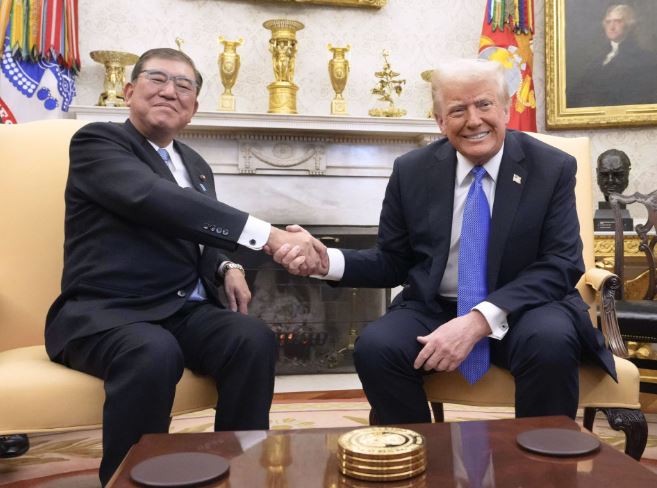
WASHINGTON – Japanese Prime Minister Shigeru Ishiba got off to a good start in building a personal relationship with U.S. President Donald Trump as they held their first summit on Friday, reaffirming the countries’ strong security and economic ties remain unchanged.
During their talks in Washington, the leaders pledged to enhance cooperation in the fields of defense, the economy and technology as well as other areas as they pursue a “new golden age” of bilateral relations.
As past leaders have done, Ishiba and Trump also confirmed that “peace and stability in the Taiwan Strait” are important and Article 5 of the Japan-U.S. security treaty applies to the Tokyo-controlled, Beijing-claimed Senkaku Islands in the East China Sea.
Ishiba unveiled plans to purchase U.S.-made liquefied natural gas and expand investment in the world’s largest economy to $1 trillion. While avoiding becoming the latest target of Trump’s tariff threats, Japan was asked to help reduce the U.S. trade deficit.
Following Israeli Prime Minister Benjamin Netanyahu, Ishiba, who took office in October, became the second foreign leader to meet with Trump since the Republican president’s inauguration on Jan. 20 for a nonconsecutive second term.
The summit, part of Ishiba’s hectic 24-hour stay in the United States from Thursday, came as the world braces for Washington’s return to unilateralism and protectionism under Trump’s “America First” banner, as seen during his first term from 2017.
At a joint press conference at the White House after the meeting, Trump and Ishiba affirmed that the bilateral alliance is the “cornerstone” of peace, security and prosperity in the Indo-Pacific region and beyond.
“The United States is totally committed to the security of Japan. We will extend the full strength of American deterrence capabilities and defense of our friend and ally, 100 percent,” said Trump, who is believed to be reluctant to engage in Asian matters.
Having failed to arrange a meeting with Trump before his inauguration, Ishiba was hoping to secure an early encounter with him to forge a personal rapport and obtain an assurance that the decades-old alliance is rock solid, a Japanese government source said.
Ishiba described his first face-to-face talks with Trump as “very meaningful,” calling him “very sincere” and a man “with a strong sense of mission.” Trump praised Ishiba as a future “great prime minister.”
Under the administration of former President Joe Biden, Japan and the United States promoted their partnership with the vision of a “free and open Indo-Pacific,” a veiled bid to counter China’s growing military and economic clout in the region.
Trump added they agreed to step up cooperation in areas such as investment, energy, artificial intelligence, cyberspace and outer space, while Ishiba said they shared the view that the two nations would “take the partnership to an even higher level.”
At the outset of the summit open to the media, Trump said he wants to work on cutting his country’s persistent trade deficit with Japan and bring it to “even,” adding using tariffs is always an option for that purpose.
Ishiba said he is determined to “work hand-in-hand” with Trump to contribute to world peace, while promising that Japan will further increase its investment in the United States.
After their meeting and a working lunch that lasted about two hours, Ishiba and Trump issued a joint statement pledging to advance “multilayered” and coordinated cooperation among like-minded nations.
The collaboration covers trilateral frameworks with South Korea and the Philippines, as well as the four-way Quad grouping with Australia and India, in which Japan and the United States have played the leading role.

Japanese Prime Minister Shigeru Ishiba (L) and U.S. President Donald Trump hold talks at the White House in Washington on Feb. 7, 2025.

Japanese Prime Minister Shigeru Ishiba (L) and U.S. President Donald Trump hold a joint press conference at the White House in Washington on Feb. 7, 2025.
China has been escalating military pressure on Taiwan as Beijing regards the self-ruled democratic island as a renegade province that must be reunified with the mainland, by force if necessary.
Article 5 obliges the United States to defend territories under Japan’s administration from armed attack. Tokyo is vigilant against Beijing’s maritime assertiveness, as Chinese coast guard vessels frequently enter waters around the uninhabited Senkaku Islands.
In the statement, Trump underscored his country’s “unwavering commitment to the defense of Japan, using its full range of capabilities, including nuclear capabilities,” which serve as so-called extended deterrence.
The statement also said Japan and the United States will collaborate in developing critical technologies such as artificial intelligence, quantum computing and leading-edge semiconductors.
Trump said Japan will “soon begin importing historic new shipments” of U.S. liquefied natural gas “in record numbers,” in the wake of his directive to boost fossil fuel production.
In response to deteriorating global security, aggravated by Russia’s full-scale invasion of Ukraine that began in 2022, Japan has been ramping up its defense budget with the goal of reaching 2 percent of gross domestic product in fiscal 2027.
Trump, who has repeatedly urged NATO allies to allocate 5 percent of GDP to defense instead of the current 2 percent target, said he hopes Japan will raise its defense spending, but he did not specify a numerical target.
Ishiba, meanwhile, said Japan will decide on hikes in defense spending “on its own initiative.” He also invited Trump for an official visit to Japan “in the near future,” which the president accepted.
BY: The Times Union






